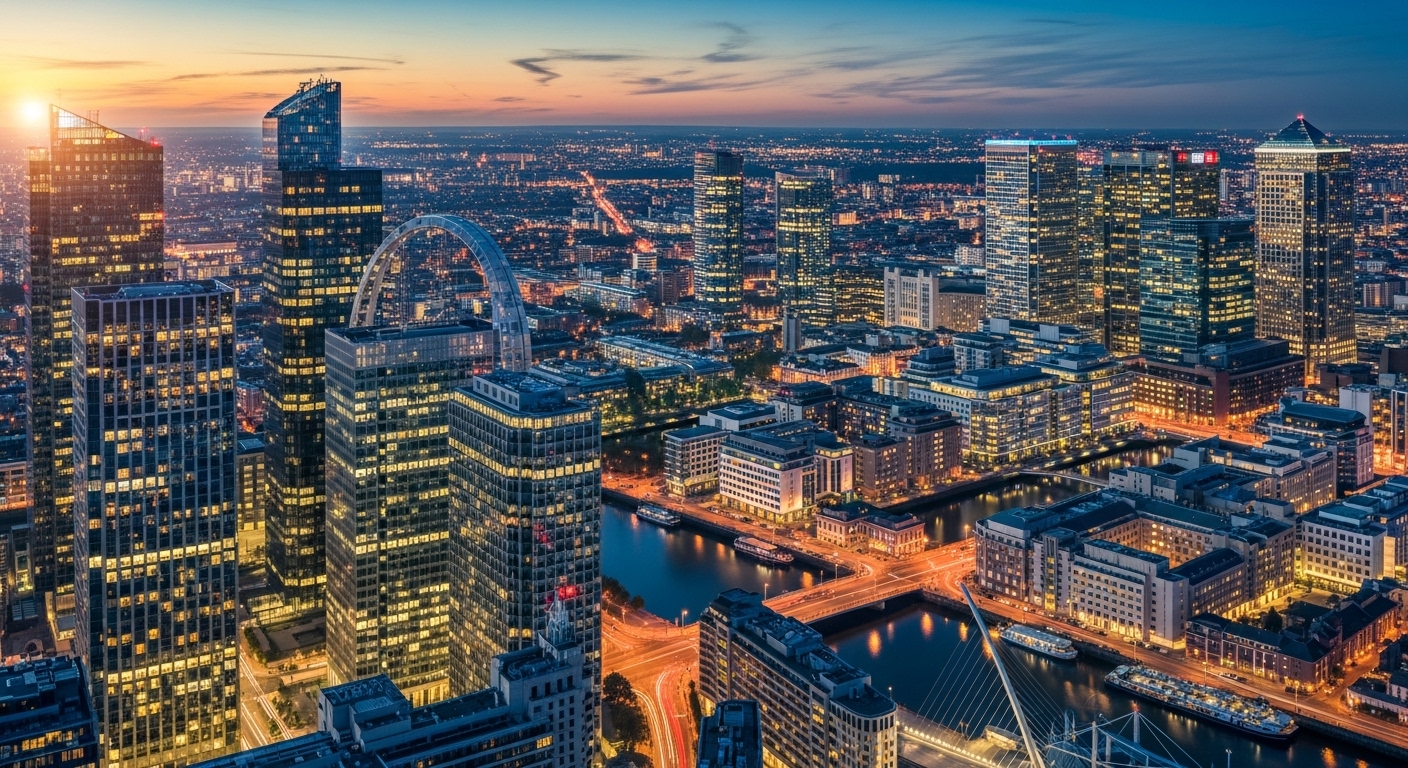In the wake of significant global shifts, from post-pandemic work models to post-Brexit economic realignments, the map of Europe’s commercial power centers is being redrawn. The long-established hierarchy, once dominated by a handful of financial capitals, is now a more complex and dynamic mosaic. Today, deciding where to establish or expand a European presence requires a nuanced understanding of not just traditional economic drivers, but also the powerful currents of talent migration, technological innovation, and evolving trade relationships. This guide navigates the continent’s most influential business districts, from the resilient legacy hubs to the disruptive challenger cities. We will explore the enduring strengths of London and Paris, the continental stability of Frankfurt, and the vibrant tech ecosystems thriving in Dublin and Amsterdam. By examining the unique characteristics of each district, we will uncover the strategic calculus businesses must now employ to attract top talent, harness innovation, and secure their foothold in the future of the European market.
London’s enduring legacy: The City and Canary Wharf
Despite the tectonic shifts of Brexit, London remains a formidable titan in the global business arena. Its two primary business districts, the historic City of London (‘The Square Mile’) and the modern Canary Wharf, continue to exert immense gravitational pull, particularly in the realms of finance, law, and professional services. The City’s strength lies in its unparalleled density of expertise and its deep-rooted history as a global financial center. It houses the Bank of England, the London Stock Exchange, and hundreds of international banks, creating an ecosystem of knowledge and capital that is difficult to replicate. This concentration fosters a powerful network effect, where proximity to clients, competitors, and collaborators accelerates business and innovation. Canary Wharf, developed in the late 20th century, offers a different proposition. Its modern, high-spec office towers attracted major investment banks and media organizations seeking larger floor plates and cutting-edge infrastructure. Together, these districts form a complementary offering that caters to a wide spectrum of corporate needs. London’s resilience is further bolstered by its vast and diverse talent pool, drawn from world-class universities and every corner of the globe. While some financial operations have relocated to continental Europe to ensure seamless EU market access, London has successfully pivoted, strengthening its position in fintech, green finance, and global tech, proving its remarkable capacity for adaptation and reinvention.
Paris La Défense: Europe’s post-brexit powerhouse
As businesses sought a stable European Union base following Brexit, Paris, and specifically its La Défense district, emerged as a primary beneficiary. Located just west of the city’s historic center, La Défense is Europe’s largest purpose-built business district, a stunning testament to modernist urban planning. Its skyline is dominated by iconic skyscrapers housing the headquarters of major French and international corporations, particularly in the banking and energy sectors. The district’s appeal is multi-faceted. It offers a vast inventory of Grade A office space with the modern amenities and large, flexible floor plans that are often scarce in the historic heart of Paris. This has been a critical factor for large financial institutions relocating staff and operations from London. Furthermore, the French government has been proactive in courting international business through regulatory reforms and incentives, streamlining the process of setting up shop. La Défense is not merely an office park; it is a city within a city, boasting excellent public transport links, including a direct connection to the city center via the RER A line and the Metro Line 1. This connectivity ensures that businesses located there can still tap into the rich cultural life and vast talent pool of the entire Île-de-France region. Its strategic development and robust infrastructure have solidified its status as a key continental alternative to London, transforming it into a crucial nerve center for finance and trade within the EU.
Frankfurt’s Bankenviertel: The continental finance capital
Often referred to as ‘Mainhattan’ for its concentration of high-rise buildings along the River Main, Frankfurt’s Bankenviertel (Banking Quarter) is the undisputed financial heart of Germany and a linchpin of the European economy. Its prominence is anchored by the presence of the European Central Bank (ECB) and the Deutsche Bundesbank, which establishes it as the epicenter of Eurozone monetary policy. This institutional foundation has created a powerful ecosystem for the financial services industry, attracting over 200 banks, including the headquarters of Germany’s largest financial institutions. Frankfurt’s strategic advantage extends beyond its institutional role. It boasts one of Europe’s busiest airports, Frankfurt Airport, providing unparalleled global connectivity for international business travelers. The city’s data center market is also one of the largest in the world, making it a critical hub for digital infrastructure and cloud computing. The Bankenviertel itself is remarkably compact and walkable, fostering a close-knit business community where crucial decisions can be made over a brief lunch. In the post-Brexit landscape, Frankfurt has successfully attracted numerous financial firms looking to establish their EU headquarters, leveraging its stability, infrastructure, and central location within Europe. While it may not possess the sheer scale of London or the cultural cachet of Paris, Frankfurt’s focused, efficient, and deeply connected business environment makes it a pragmatic and powerful choice for companies at the heart of European finance.
Dublin’s Silicon Docks: The gateway for global tech
On the banks of the River Liffey, Dublin’s docklands have undergone a breathtaking transformation from post-industrial decay to one of the world’s most important technology hubs, earning the moniker ‘Silicon Docks’. This district’s rise is a masterclass in strategic economic planning. Ireland’s competitive corporate tax rate was the initial catalyst, attracting the European headquarters of global tech behemoths like Google, Meta (Facebook), Apple, and LinkedIn. However, the ecosystem has since evolved far beyond a simple tax advantage. These anchor tenants created a powerful gravitational field for talent, drawing skilled tech professionals from across Europe and beyond. This, in turn, fueled a vibrant and self-sustaining startup scene, with a network of venture capitalists, incubators, and accelerators supporting homegrown innovation. The presence of both established giants and nimble startups creates a dynamic environment ripe for collaboration and knowledge sharing. The Silicon Docks area is characterized by modern office campuses interwoven with residential apartments, restaurants, and cultural venues, creating a lively work-life environment that is highly attractive to a young, international workforce. As the primary English-speaking country in the EU, Ireland offers a seamless entry point for US companies looking to tap into the vast European market. This combination of a favorable business environment, a deep talent pool, and a dynamic ecosystem has cemented Silicon Docks’ reputation as the undisputed European gateway for global technology.
Amsterdam’s Zuidas: a hub for connectivity and trade
Strategically located between Amsterdam’s city center and Schiphol Airport, the Zuidas (South Axis) has rapidly evolved into the Netherlands’ premier international business district. Its success is built on a foundation of exceptional connectivity. A dedicated train station within the district provides a direct, six-minute link to one of Europe’s best-connected airports, making it an incredibly efficient location for international business. This logistical advantage is complemented by the Netherlands’ historic strength in trade and its open, multilingual culture. Zuidas is home to a diverse mix of companies, from major financial institutions and law firms to the European headquarters of technology and pharmaceutical companies. The district has also become a key beneficiary of post-Brexit relocations, with organizations like the European Medicines Agency choosing it as their new home. What sets Zuidas apart is its commitment to creating a sustainable and livable urban environment. The master plan for the district integrates high-density office space with residential buildings, green spaces, and high-quality public amenities. This focus on work-life balance and sustainability is a major draw for top international talent who value quality of life as much as career opportunities. Amsterdam’s progressive and innovative spirit pervades the Zuidas, making it not just a center for commerce, but also a forward-thinking hub for businesses focused on sustainability, technology, and global collaboration.
Berlin and the Nordics: The innovation frontier
While traditional capitals anchor Europe’s finance and trade, a different kind of energy is powering the continent’s innovation frontier, with Berlin and the Nordic capitals like Stockholm and Helsinki at its core. Berlin’s appeal lies in its unique cultural fabric and affordability. The city’s creative, counter-cultural vibe has made it a magnet for artists, entrepreneurs, and technologists from around the world. This has fostered a bottom-up startup ecosystem that is one of the most vibrant in Europe, particularly in sectors like e-commerce, mobility, and creative tech. Unlike the buttoned-down atmosphere of Frankfurt or London, Berlin offers a more informal and collaborative business environment, supported by a vast network of coworking spaces and incubators. The Nordic capitals, meanwhile, offer a model of highly specialized, tech-driven economies. Stockholm, for example, is a global powerhouse in fintech and gaming, having produced unicorns like Klarna and Spotify. This success is built on a foundation of high levels of education, widespread English proficiency, and a strong social safety net that encourages entrepreneurial risk-taking. These cities consistently rank among the highest in the world for quality of life, sustainability, and innovation. For companies focused on cutting-edge technology, design, and attracting talent that prioritizes a progressive and balanced lifestyle, the districts within Berlin and the Nordic capitals represent the dynamic future of European business, driven less by legacy and more by creativity and forward-thinking policy.
The new calculus: ESG, talent, and hybrid work
Beyond the specific attributes of any single district, a new set of strategic factors is universally shaping corporate location decisions across Europe. Environmental, Social, and Governance (ESG) criteria have moved from a peripheral concern to a central pillar of corporate strategy. Companies are now under immense pressure from investors, employees, and customers to operate sustainably. This translates directly into real estate decisions, with a growing demand for buildings with high BREEAM or LEED certifications, access to public transport, and features that promote employee well-being. A building’s green credentials are no longer a bonus but a necessity for attracting and retaining top-tier corporate tenants. Simultaneously, the global war for talent has intensified, making a city’s overall quality of life a critical business asset. Companies are increasingly choosing locations not just for their business infrastructure but for their culture, schools, green spaces, and general livability. The rise of hybrid work has further complicated this calculus. With employees no longer needing to be in the office five days a week, the purpose of the office is shifting. It is becoming less a place for individual-focused work and more a hub for collaboration, culture-building, and mentorship. This means businesses are prioritizing office districts that are easily accessible and surrounded by amenities that enhance the in-person experience, making the commute worthwhile and fostering a sense of community that cannot be replicated remotely.
Conclusion
The landscape of European business districts is more fragmented and competitive than ever before. The era of a single, dominant hub has given way to a polycentric model where a diverse array of cities offers specialized advantages. The legacy powerhouses—London’s City, Paris’s La Défense, and Frankfurt’s Bankenviertel—continue to wield immense influence, particularly in global finance, leveraging their deep pools of capital and expertise. Yet, they are constantly challenged by dynamic challenger hubs. Dublin’s Silicon Docks has firmly established itself as the continent’s tech gateway, while Amsterdam’s Zuidas excels in connectivity and trade, and cities like Berlin and Stockholm lead the charge in raw innovation and startup culture. Ultimately, the strategic choice of where to locate is no longer a simple calculation of cost and market access. It is a complex equation that must balance industry focus with the critical, modern-day imperatives of attracting and retaining top talent, meeting stringent ESG standards, and adapting to the fluid realities of hybrid work. For businesses aiming to thrive in Europe, success lies not in finding the one ‘best’ location, but in identifying the district that aligns perfectly with their unique strategic vision and cultural values in this ever-evolving continental mosaic.





